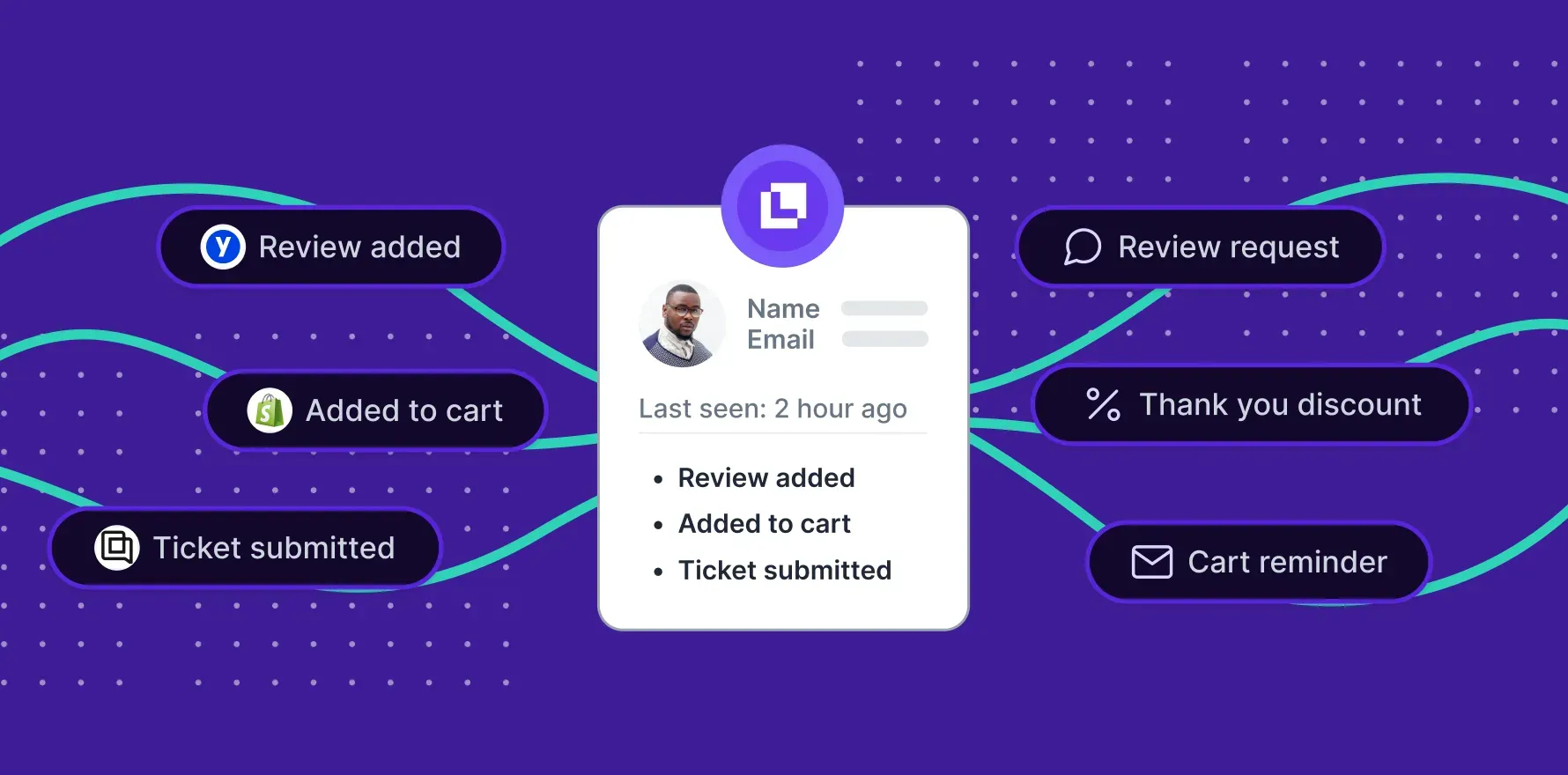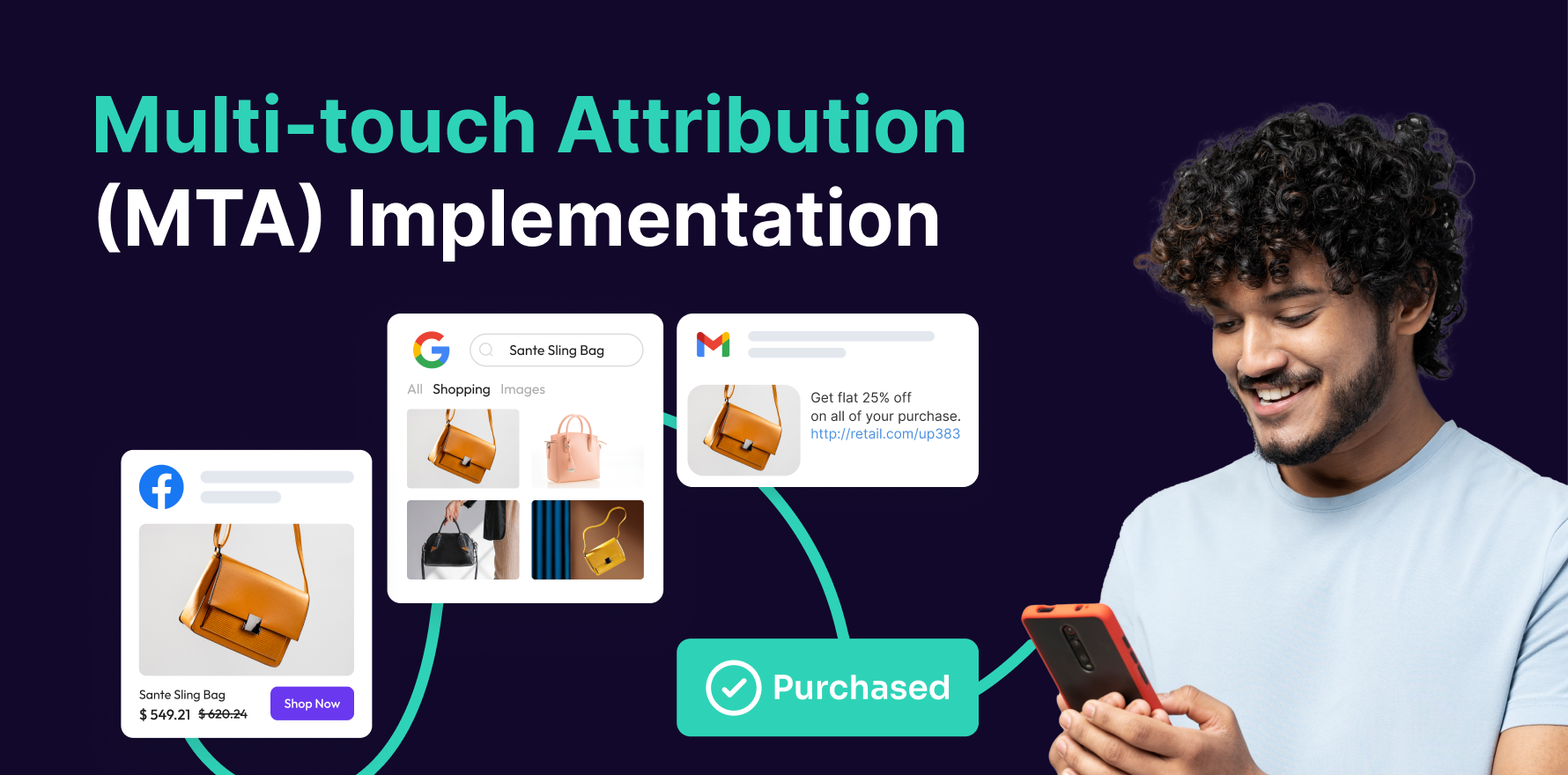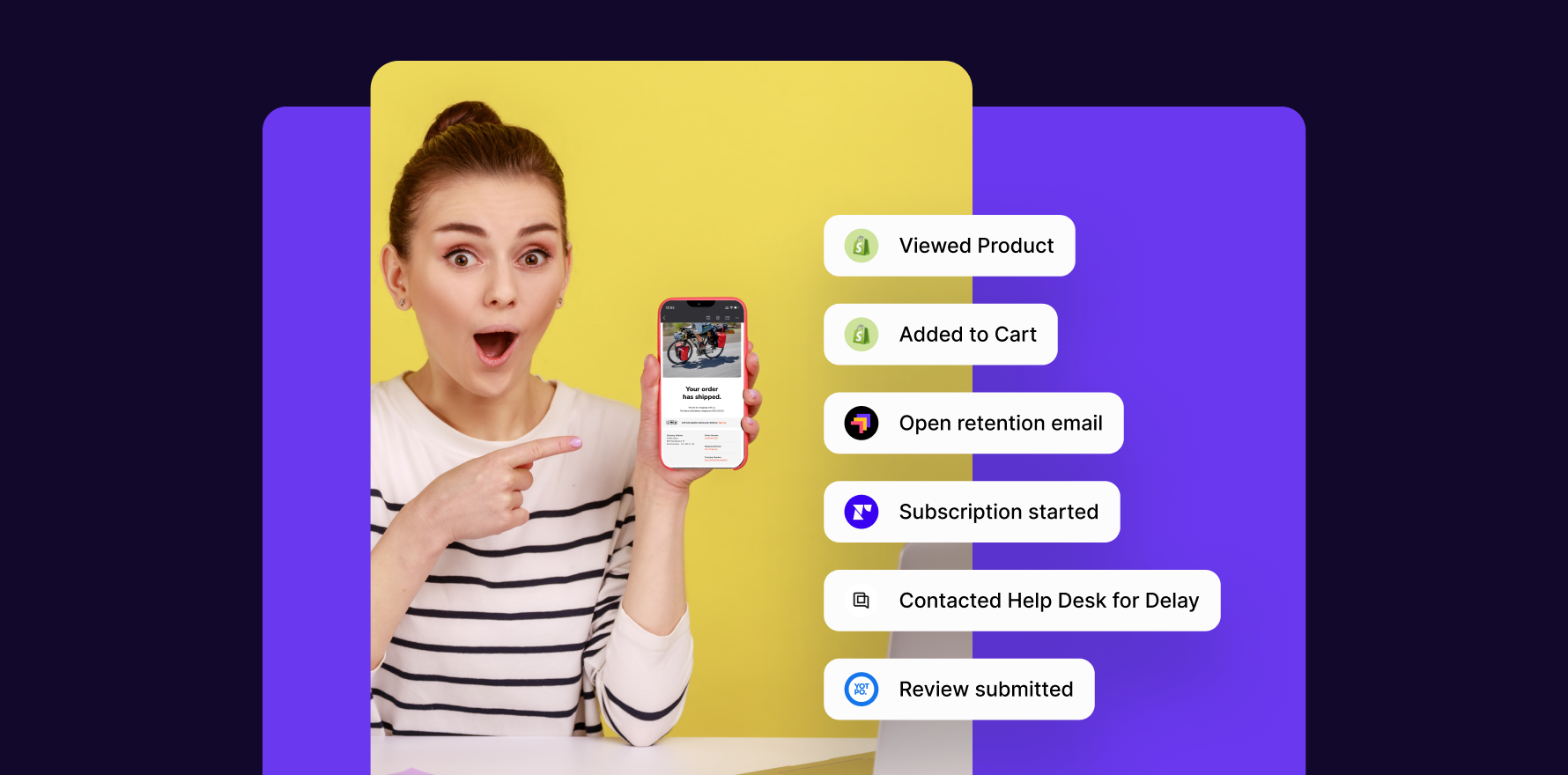Pick any innovative and successful DTC brand off the top of your mind.
We bet that that brand will be using at least 10 different tools to enhance customer experience and delight. For instance,Fussy, a UK-based DTC brand that manufactures deodorants, uses the following stack under the hood:
- Two tools for Subscription
- Two tools for analytics
- Customer support
- Two tools for reviews
- For upselling
- A tool for creating landing pages
- A tool for referral
- And one for SMS-based marketing
Feeling the heat?
With every customer interaction and transaction being tracked, recorded, and stored, DTC brands are inundated with high-quality first-party data. Whether this is all for nothing is determined by how well the brands collect, store, and act on it.
And this is precisely why you need a Customer Data Platform (CDP).
What is a CDP?
Customer data analytics are revolutionizing the business world. A CDP is a prebuilt technology used by marketers and customer experience professionals to understand their brand’s customers and scale hyper-personalized experiences across marketing, sales, and service channels.
Customer data is often split up and stored in different systems. Even if it’s all in one place, non-technical teams will have a hard time getting what they need, making sense of it, and using it to create personalized experiences without learning to code or asking IT and data science teams for help.
In short, DTC brands need technology that:
- Unifies all customer data
- Provides an easy-to-use interface for managing data
- Segments audiences
- Generates predictive insights
- Ensures that all marketing, sales, and customer service channels work together smoothly.
This technology is called a CDP.
What a CDP is not
Whileoften compared to a CRM (Customer Relationship Management)and DMP (Data Management Platform) systems, CDPs are different and highly evolved than both.
A CDP collects more types of data (behavioral and transactional in real time, structured and unstructured), and provides value throughout the whole customer lifecycle, not just one stage.
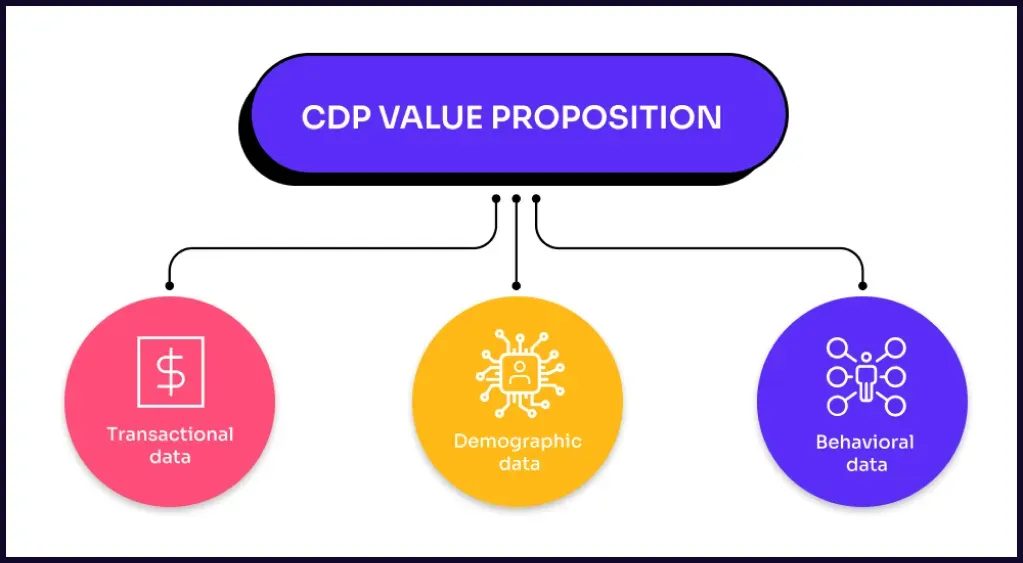
Why should your DTC brand use a CDP
CDPs empower business users, modern marketers, and data analysts to leverage all available data and insights to make every customer engagement count.
CDPs:
- Consolidate data silos
- Create a 360-degree customer view
- Democratize access to customer data for purposes of personalizing interactions across marketing, sales, and customer support channels
Ultimately, CDP data gives modern marketers and CX professionals at DTC brands the ability to provide a real-time hyper-personalized experience to their customers by consolidating data silos and automating authentic customer interactions across multiple touchpoints and channels.
A delightful CX is essential to acquiring, retaining, and building long-lasting relationships with customers. Hyper-personalization is the foundation of exceptional CX — and is impossible to achieve without unified customer data.
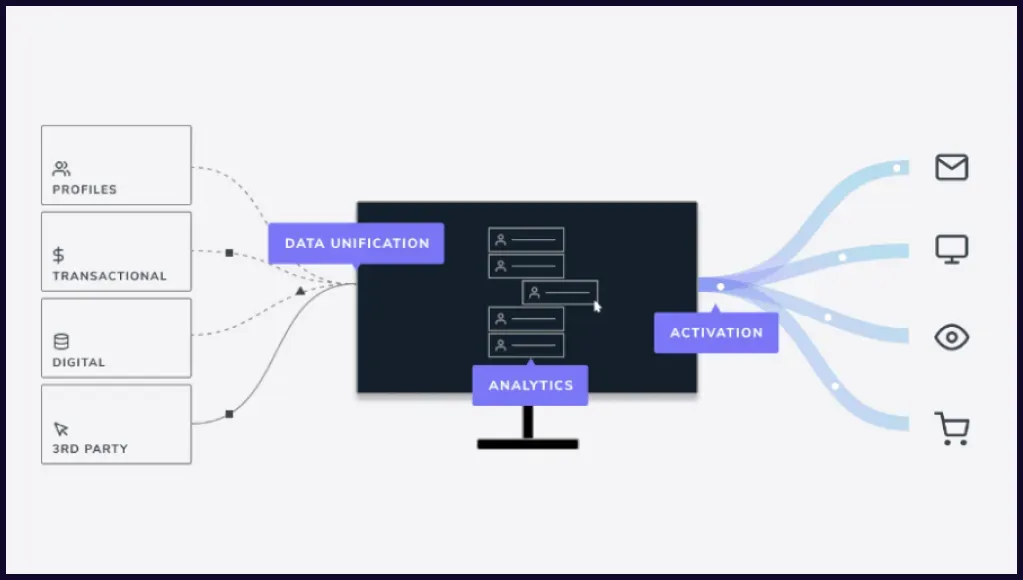
Without a CDP in place, your DTC brand will go through:
- Delays (in communication, responses, and actions based on real-time customer interactions and engagements)
- Missed market opportunities
- Wasted time and effort
- Increased expenses
- Cross-functional friction
- Disjointed customer experiences
- Unsatisfactory customer service
- Competitive risk
CDPs resolve these pain points and enable DTC brands to ensure that their customer data is accurate, accessible, and actionable. This makes it possible for your brand to provide theright customerswith theright, relevant, and hyper-personalized experiencesat the right time (in real time), irrespective of the channel or touchpoint they’re on.
They’ve got mad skills: 5 basic functionalities
CDPs need customer data to function. This customer data comes in the form of first-party data, that is, data collected by a brand and only used for that brand’s marketing.
Third-party data, as opposed to first-party data (data gathered directly from the consumer), consists of user information that corporations purchase and/or exchange with other organizations. In addition to being incorrect and erroneous, data from third parties may have been taken without authorisation.
This is less likely with first-party data, as you will know precisely how, when, where, and why the data was gathered. Those are important questions to answer when you’re evaluating data accuracy and compliance with data privacy regulations.
1) Data integration management
A CDP enables you to collect data from every channel and platform where customers engage with your brand (also, called data ingestion). This includes your owned platforms such as your website and mobile app. It also includes your advertising channels, as well as your email, CRM, and payments systems. Also, the CDP enables you to collect customer data from your servers for greater reliability and accuracy.
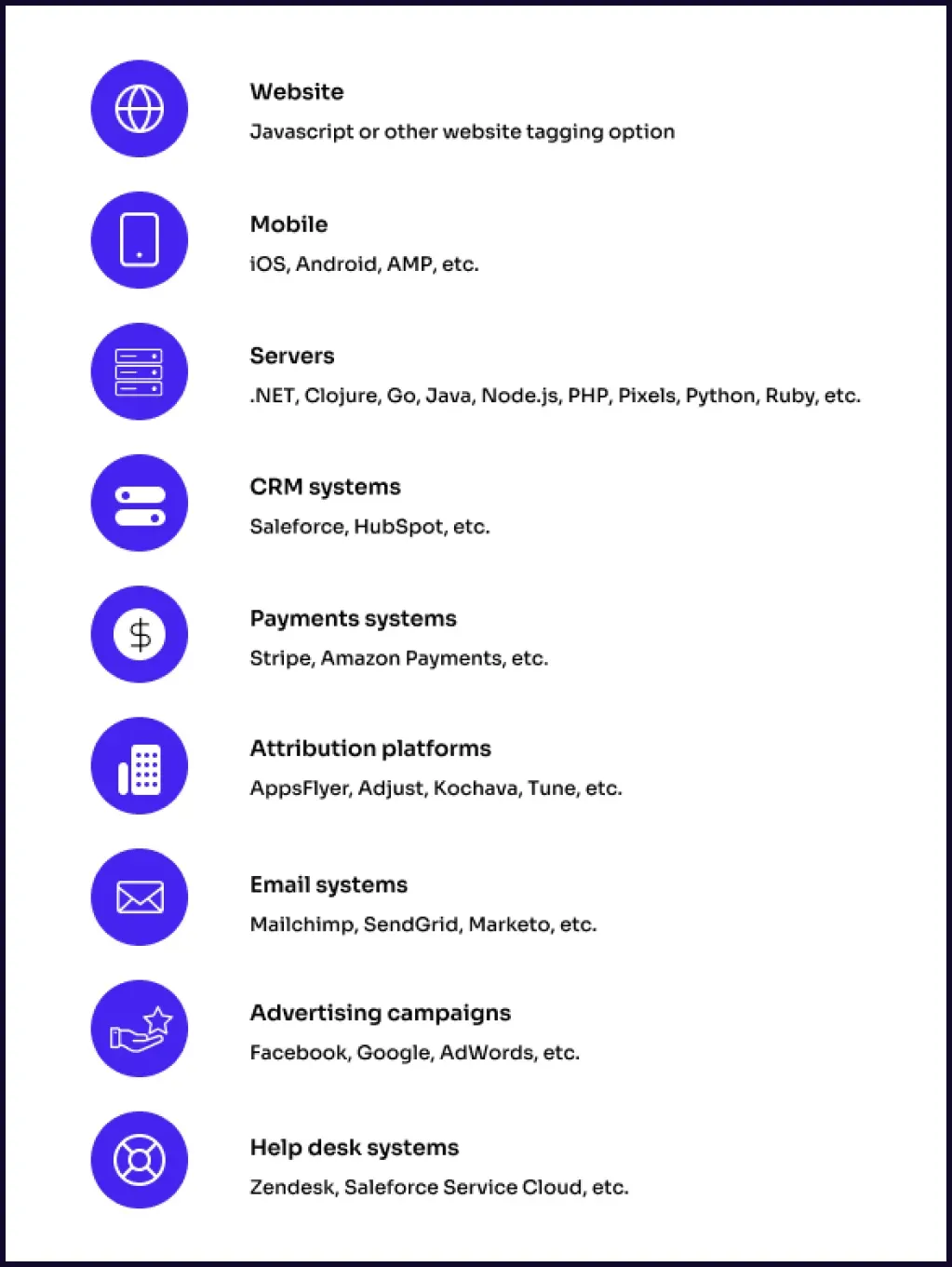
In simple words, a CDP is most useful when it enables you to capture complete customer data from wherever your customers interact with your brand.
Through a process known as customer data integration, CDPs make your first-party data meaningful to you. Customer data integration (CDI) is the process of merging and arranging customer data from many databases into a single, more useful and accessible format in order to improve analytical capabilities.
The CDP serves as the technology layer between your digital properties and customer data tools. This means a CDP enables you to collect a master set of customer data and then activate that data in the tools your team relies on.
A core competency of a CDP is the ability to easily route data to the tools you use. Once set up, your CDP allows you to easily turn on and off new integrations – think of your CDP as the last integration you ever have to do.
Data silos occur when there is a barrier between two or more data collections. It inhibits you from obtaining a comprehensive view and making accurate judgments based on your data.
So, in summary, a CDP ingests and consolidates all the raw data across your offline and online sources, including cross-channel data.
Why do you need customer data integration?
Customer data integration is a critical functionality of a CDP. It allows more informed decision-making, improves business intelligence, gives you a full view of your customer’s journey, and makes the customer experience even better.
A CDP will integrate with the software your brand uses to run, such as Shopify, WooCommerce, Salesforce, AWS, Zendesk, Google Analytics, etc.
Then it aggregates and collates the data inside all these software/tools to provide value for your brand via unified data profiles of specific customers and customer types.
Just imagine the possibilities!
2) Single unified view of the customer
Today’s customers access their accounts and/or buy products from any DTC brand via:
- Smartphones
- Desktops at work
- Apps
- Websites
- SMS
- Chatbots
Historically, it’s been difficult for all of these systems to recognize a single user, and collect one profile on their usage habits across all devices and browsing experiences.
That meant it was even more challenging for marketers to understand when it’d be best to reach out to a customer, on which device, and about which products – making truly hyper-personalized marketing an elusive dream.
This is where a CDP flexes its muscles and enters the arena.
A CDP’s primary purpose is to build a dynamic, comprehensive, and unified profile of all your customers. It does this by pulling data from all your various systems and touchpoints (transactional history, customer service interactions, IoT data from their smart devices, etc.), cleaning and organizing that data, and then combining it into a single view via a customer identity resolution engine.
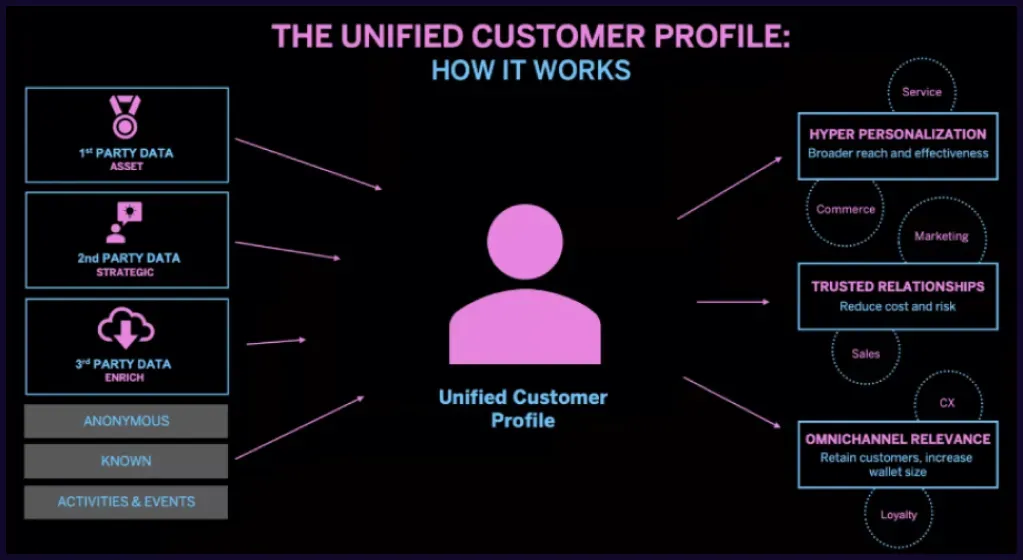
Why do you need a unified customer profile?
You need a unified customer profile to understand the entire customer journey and accurately build audiences to drive hyper-personalization. Customers expect that you accurately understand their history and real-time behavioral and transactional data when you communicate with them, irrespective of the channel.
3) Behavioral segmentation
CDPs are uniquely engineered to create custom segments based on any real-time first-party data you have collected.
The CDP makes it easy to activate these segmented customers across your advertising networks, marketing tools, and owned applications.
Why do you need behavioral segmentation?
Without a CDP, most marketing teams:
- Are unable to refresh their segments
- Overspend on advertising
- Send irrelevant emails/SMSes to their customers/users
If you are interested in driving hyper-personalization, adopt a CDP that synthesizes raw data into traits and actions for each customer.
4) Personalized Omnichannel Marketing
Years ago, digital transformation killed the linear sales funnel model, but we think that quite a few DTC brands may have missed attending its funeral. 🙂
With a CDP, not only does it let you collect all of your customers’ information in one place, but it also helps your business identify and respond to the right customers at the right time using real-time, first-party data.
Once you know who your customers are and use this information as the foundation for your omnichannel customer journeys, you can get rid of irrelevant or unnecessary multi-channel marketing and customer service interactions.
Keep in mind that speed is a necessity. Consumers expect you to tailor your messaging and responses in real time, whether it’s a digital ad, an email, an SMS or live chat via your app or website, etc.
Via a CDP, you can schedule omnichannel experiences for your customers in advance by defining a one-time activation or customer experiences to be pushed automatically at a predefined frequency.
Your hyper-personalized well-crafted customer experiences/messaging for each customer journey stage, including welcome messages, abandoned event reminders, and post-purchase messages will go a long way in making omnichannel marketing work for you.
This way you can automatically guide customers through the customer journey based on their unique qualities—and across the different channels/touchpoints that matter most to them.
Also, don’t forget that not all channels are the same. Your customers will have preferences about which channels they use the most and bring in the most revenue. Therefore, a CDP allows you to put your marketing dollars behind the channels proven to move the needle the most.
5) Real-time data orchestration
A CDP supports the orchestration, testing, and measurement of experiences across all customer touchpoints.
This means orchestrating ad-hoc, triggered, and journey-based experiences from a single user interface to all marketing, sales, and customer service channels in real time, as well as configuring tests across any channel and measuring performance using customizable business metrics or machine learning algorithms that automate experience optimization.
In simple words, real-time data orchestration means that the CDP enables data optimization and analytics, and sends just the relevant customer data that is needed to the appropriate touchpoints to accomplish business goals.
Why do you need data orchestration?
An orchestration-enabled CDP can connect to multiple interactions across any channel by pulling together offline and online data in real time to form unique customer journeys.
This customer journey mapping capability allows you to visualize individual customer journeys across multiple channels while understanding their interaction preferences and the context behind their actions.
All this is done at scale no matter where your customers are in their journey, and helps deliver in-depth insights into how you can further personalize it.
Data orchestration is the process of breaking down data silos so that your data isn’t scattered and you can get to it quickly.
This functionality enables you to decide what action to take based on the customer’s real-time behavior via automated triggers. For example, you can set up an automated trigger to send an email and/or SMS via any third-party tool to a customer if they abandon their shopping cart:
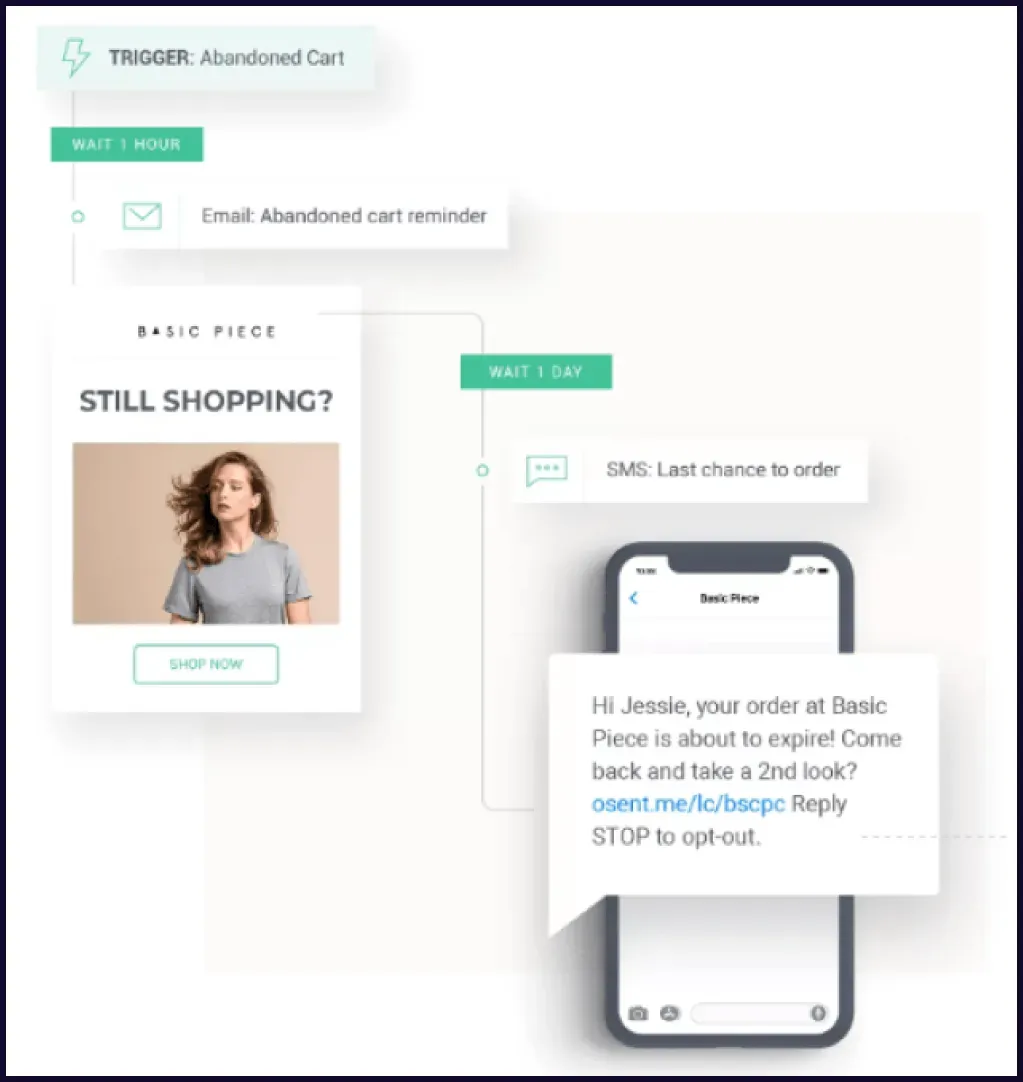
Top 3 use cases of a CDP
1) Forecast churn via analytics
In modeling and forecasting customer behavior, a CDP uses artificial intelligence to augment customer insights. This entails segmenting and targeting audiences, as well as performing advanced analytics and applying machine learning models into practice throughout the complete history of customer behavior.
CDPs do most (or all) of the hard work of preparing data for predictive analytics by gathering raw, disparate customer data and combining it into a single customer view. From there, you can instantly apply prebuilt predictive algorithms to the data.
You can use AI and machine learning capabilities of a CDP to quickly forecast the likelihood of customer churn, uncover ideal send times, create lookalike audiences, and more.
For instance, you can predict which customer is likely to reorder a certain product or product category based on purchase history and past/real-time behavior across multiple touchpoints on your channels.
You can also use the CDP’s analytics capabilities to measure and track the performance of your campaigns and their outcomes.
2) Hyper-personalize omnichannel marketing
Use both real-time and historical data to develop customized, highly relevant omnichannel marketing scenarios, which in turn can convert each touchpoint to be shoppable. You can create multi-step customer journeys — as well as triggered and scheduled real-time experiences — that are tailored to customers’ behaviors and preferences across all online channels and touchpoints.
For example, let us assume your DTC brand sells jewelry. Your accessories that cost less than $300 sell out quickly, but people tend to leave behind more expensive items. This might be fine for you, since you know that people take longer to decide to buy more expensive jewelry.
At this point, a CDP lets you test different cart abandonment strategies based on the value of the cart. For the cheaper carts, you can only send messages to remind shoppers of the items they have in their cart. For the higher value carts, your messages may offer some sort of assistance (or even a discount):
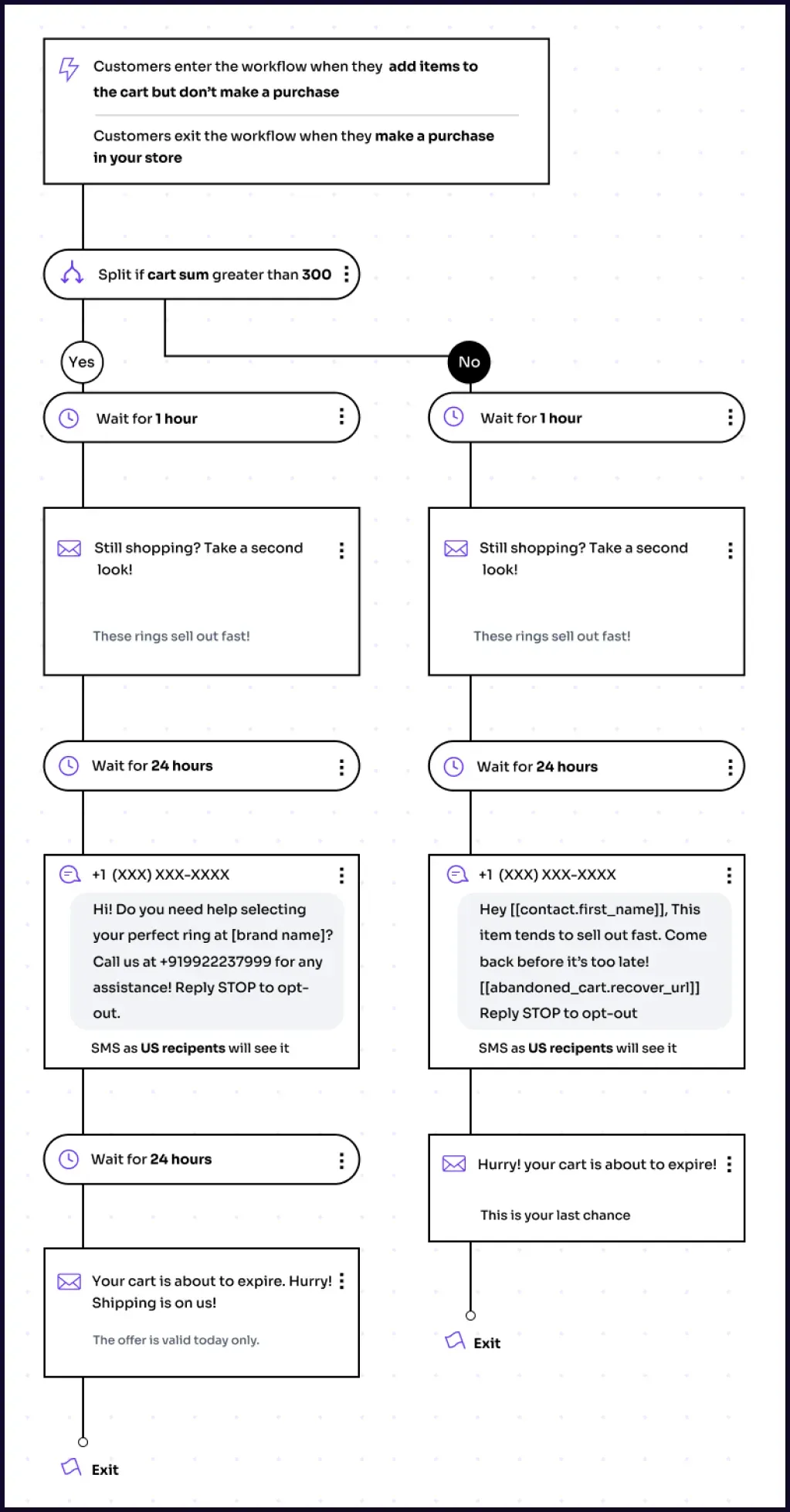
Such a hyper-personalized journey matters to the customers and directly influences the CLV.
3) Automate your CX
CDPs provide automated orchestration of tailored, real-time customer experiences across all marketing, sales, and customer support channels via multi-step customer journeys and triggered or scheduled events.
You can design journeys, monitor experiences, A/B test variations, utilize control groups, report on performance, and much more to optimize CX over time.
For instance, if a customer has not ordered from you in the last one month, you can automate a series of hyper-personalized email and SMS messages for him/her with an appropriate discount on his/her favorite or last ordered or complementary product. And if he/she responds by visiting your website or app to add that product to the cart, you can automate his/her preferred payment mode, based on past transaction/behavior, and post-purchase service/support calls accordingly.
Become the smartest marketer in the room powered by a CDP’s mad skills!
DTC brands have been trying to make the most of their customer data since the beginning of digital transformation.
Over the years, many tools have come out on the market, but until CDPs, brands didn’t have the technology they needed to combine, analyze, and use their customer data on a large scale.
The only challenge every modern marketer will face is the proliferation of channels… For instance, the never-ending wave of new social media apps and sites. This means more interactions to keep track of and more customer records to resolve into a golden record.
At Lifesight, something’s brewing that will certainly make you the smartest marketer in the room.
You may also like
Essential resources for your success
